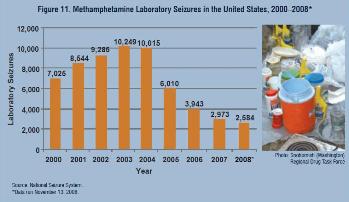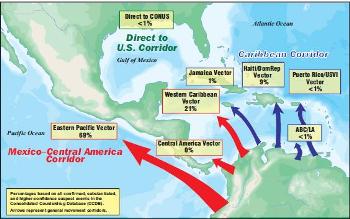Well, not in so many words. But anyone reading between the lines of the National Drug Intelligence Center's National Drug Threat Assessment 2009 could easily come to that conclusion. The annual report from the Justice Department fiefdom based in Johnstown, Pennsylvania, with its thoroughly inside-the-box approach to the harms associated with drug policy, does not look at the data it is reporting and see the obvious, but its conclusions that violent drug trafficking organizations and street-level drug retail gangs are the gravest "drug threats" to America beg the question of why.

Following close on the heels of the bloody cartels -- 5,000 have been killed in Mexico's prohibition-related violence this year -- are the cartel wannabes: "Violent urban gangs control most retail-level drug distribution nationally, and some have relocated from inner cities to suburban and rural areas. Moreover, gangs are increasing their involvement in wholesale-level drug distribution, aided by their connections with Mexican and Asian DTOs."
While the violence of the cartels and the gangs is deplorable, the NDIC assessment makes no effort to address its root cause: the regime of drug prohibition. Instead it conflates the harms associated with prohibition (fighting the drug trade) with those associated with drug use or abuse.
That conceptual confusion is evident from the very beginning
of the annual report. In the first paragraph of its summary,
the report observes that: "The trafficking and abuse of
illicit drugs inflict tremendous harm upon individuals,
families, and communities
throughout the country. The violence, intimidation, theft,
and financial crimes carried out by drug trafficking organizations
(DTOs), criminal groups, gangs, and drug users in the United
States pose a significant threat to our nation. The cost
to society from drug production, trafficking, and abuse
is difficult to fully measure or convey."
Without pulling apart the harms associated with "trafficking and abuse of illegal drugs," the NDIC is conducting an exercise in futility and propaganda. The harms associated with the growth of powerful criminal organizations thriving under a prohibition regime are an entirely different matter from the harms related to drug use, misuse, or abuse, and failing to disentangle them is a service to no one. Similarly, the failure to disaggregate "DTOs, criminal groups, gangs, and drug users" only strengthens the same skewed view of the results of our drug policies.
In the summary's eight bullet points designed to demonstrate the harm of "drugs," four of them -- cartel money laundering, federal anti-drug spending, the huge number of drug arrests, and the high number of federal drug prisoners -- are a direct consequence of drug prohibition. Two others -- a large number of people seeking drug treatment, and children removed from meth labs -- are at least indirectly influenced by drug prohibition. Many people seeking treatment are doing so because of rote court orders, and many home meth cooks would likely simply purchase their drug instead of cooking it if allowed to do so. One bullet point -- that diversion of pharmaceutical drugs is costing insurance companies millions -- is yet another artifact of a prohibition regime, or at least one where access to desired drugs is so restricted that diversion occurs.
The final bullet point -- some 35 million Americans used an illicit drug (or a licit drug illicitly) -- is essentially meaningless without indicating in some way just how those people were actually harmed by using those drugs. But that is typical of a mindset that measures success in drug policy solely by reducing drug use instead of looking at the bigger picture.

Such an attitude is also apparent in the report's blunt ranking of the leading threats by drug: "Cocaine is the leading drug threat to society. Methamphetamine is the second leading drug threat, followed by marijuana, heroin, pharmaceutical drugs, and MDMA (also known as ecstasy) respectively."
Given that marijuana is almost universally understood to be one of the least harmful psychoactive substances known to man (see Professor David Nutt's "rational scale" here), marijuana's role as a leading drug threat -- ahead of heroin and pharmaceuticals! -- can only be attributed to its widespread popularity. Again, instead of demonstrating specific harms associated with marijuana consumption, the report simply assumes that marijuana use generates harm.
By NDIC standards, some progress is being made in combating the drug scourge. The report cites declining cocaine availability and purity in some US markets, and a decrease in domestic meth production (although it warns of a looming increase). But even where NDIC can point to successes, it either misses the costs of waging the drug war or conflates them with the harms of drug use.
And with marijuana in particular, it cannot even claim success. Despite record plant seizures and marijuana arrests last year: "Marijuana availability is high throughout the United States. Outdoor cultivation is going through the roof, thanks in part, the report says, to Mexican DTOs expanding into US public lands, and indoor cultivation has increased "because of high profit margins and seemingly reduced risk of law enforcement detection."
What the National Drug Threat Assessment 2009 shows us is that we are continuing to wage a futile struggle to suppress drug use at a great cost to our society. In failing to disentangle and disaggregate the social ills resulting from our prohibitionist drug policies from the social ills resulting from drug use, it is business as usual. But what do we expect from a drug war bureaucracy motivated mainly by inertia and the imperative of preserving next year's budget?